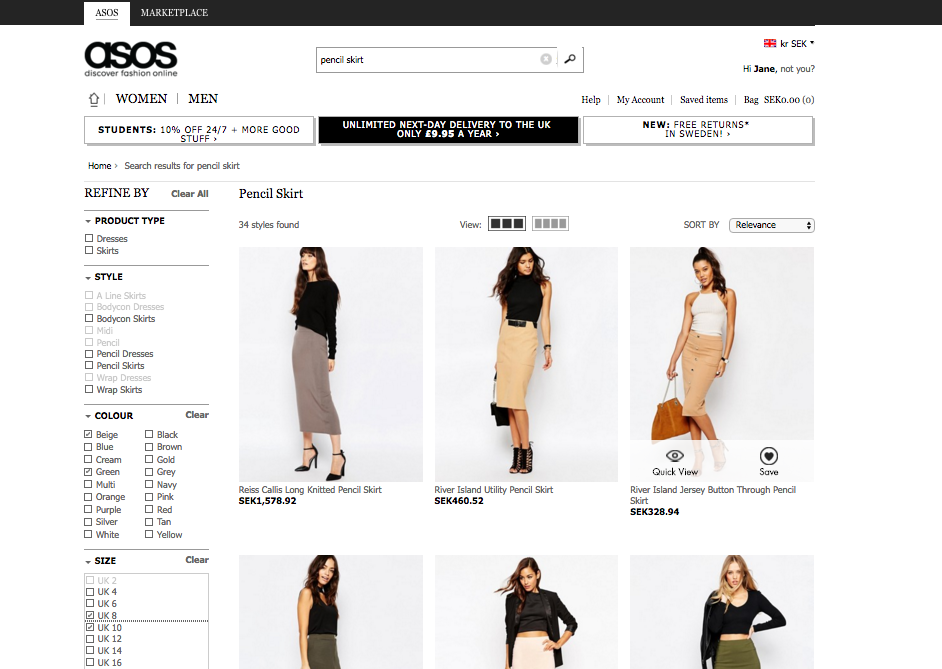Faceted Search: Simplifying Product Discovery on Your Site

Faceted search is a dynamic tool that transforms how users find products on your website, making the search process both efficient and user-friendly. By allowing shoppers to filter results based on specific attributes like size, color, price, and brand, it streamlines the journey towards the perfect product. This approach not only enhances the shopping experience but also significantly reduces the time customers spend searching for what they need. In this blog, we'll explore how faceted search engine works, its importance for ecommerce sites, and practical steps for implementing it on your own site to improve product discovery and customer satisfaction.
What is a Faceted Search?

A faceted search is a way for users to navigate a website's inventory using filters to narrow down search results. This feature allows shoppers to refine their search criteria based on specific product attributes such as size, color, price, or brand. For example, on an online clothing store, customers can use faceted search to display only the items that meet their specific needs, like all red dresses in a size medium. This method of searching makes it significantly easier and faster for users to find what they're looking for by systematically eliminating options that don't match their preferences, leading to a more satisfying and efficient shopping experience.
Faceted Search Best Practices
Implementing advanced faceted search on your website can greatly enhance user experience, but it's essential to follow best practices to ensure it serves your customers effectively. Here are some key guidelines:
- Relevant Facets: Choose facets that are most relevant to your users and your products. For an apparel site, size, color, and brand might be critical, whereas for electronics, users might prefer filters like brand, price range, and features.
- User-Friendly Interface: Ensure the ecommerce faceted search interface is intuitive. Users should be able to easily add or remove filters without confusion or difficulty.
- Prioritize Popular Facets: Place the most commonly used facets at the top or in an easily accessible area. Analyze user behavior to understand which filters are used most and prioritize accordingly.
- Limit Options: Too many options can overwhelm users. Where possible, consolidate similar facets and limit the number of choices within each category to prevent decision fatigue.
- Dynamic Filtering: The facet options should dynamically update based on the search results, showing only the filters relevant to the currently displayed products.
- Clear Indicators for Selected Filters: Make it clear which filters have been applied by using visual cues. Providing an easy way to clear all or individual filters can enhance user experience.
- Performance Optimization: Ensure that adding filters does not significantly slow down the search results. Fast, responsive searches encourage users to continue engaging with your site.
Faceted Search Benefits
Faceted search offers several benefits that significantly enhance the user experience on a website, particularly for ecommerce platforms where product variety can be overwhelming. Here's how both customers and site owners stand to gain:
For Customers:
- Enhanced Navigation: Users can easily narrow down search results by applying multiple filters, making it simpler to find products that meet their specific criteria.
- Time-Saving: Faceted search reduces the time spent sifting through irrelevant products, leading to a faster and more efficient shopping experience.
- Improved Decision Making: By allowing users to compare products based on selected attributes, faceted search supports better-informed purchasing decisions.
For Site Owners:
- Increased Conversion Rates: By simplifying the product discovery process, faceted search helps users find what they're looking for more quickly, which can lead to higher conversion rates.
- Improved Customer Satisfaction: A positive search experience can enhance overall satisfaction, encouraging repeat visits and loyalty.
- Valuable Insights: The use of faceted search provides site owners with data on user preferences and search behaviors, which can inform inventory decisions, marketing strategies, and website improvements.
- SEO Benefits: Well-implemented faceted search can contribute to the site’s SEO strategy by creating filter-based landing pages that can be indexed by search engines, potentially increasing traffic.
How to improve Shopify faceted search with AI?

Improving Shopify's faceted search with AI involves leveraging artificial intelligence to enhance the accuracy and relevance of search results, thereby providing a more personalized shopping experience. Manifest AI, for example, can play a pivotal role in this process by intelligently analyzing customer behavior and preferences to refine search filters and results by designing AI & GPT powered faceted search.
Here’s how AI, through platforms like Manifest AI, can enhance faceted search on Shopify:
- Personalized Search Filters: AI can dynamically adjust search filters based on user behavior and preferences, displaying the most relevant options to each shopper.

- Predictive Search Results: By understanding past search queries and purchase history, AI can predict and prioritize products that are more likely to interest the user, even adjusting results in real-time.

- Improved Product Recommendations: Beyond basic search, AI can suggest complementary products, enhancing discovery and potential upsell opportunities.

- Conversational Starters: Let AI help you in starting the conversation with the bot and ultimately provide you a relevant answer.

- Enhanced Search Accuracy: AI algorithms can continually learn from interactions, improving the accuracy of search results over time and reducing the likelihood of irrelevant findings.

Integrating Manifest AI into your Shopify store not only streamlines the faceted search experience but also transforms it into a powerful tool for driving sales and improving customer satisfaction. By harnessing AI, retailers can offer shoppers a highly intuitive and efficient way to find exactly what they’re looking for.
5 Best Faceted Search Examples
Faceted search has become a cornerstone of efficient online navigation, allowing users to quickly refine their searches based on specific criteria. Here are five outstanding examples of faceted search in action:
- Amazon: Amazon's faceted search lets shoppers filter products by various attributes such as category, customer ratings, brand, price, and more. This system simplifies the process of finding products in its vast inventory.
- Etsy: Specializing in handmade or vintage items, Etsy uses faceted search to help users filter products by color, type, price, and materials used. It's particularly useful for narrowing down unique gift ideas.
- Zillow: In the real estate world, Zillow offers a comprehensive faceted search that includes filters for price range, number of bedrooms and bathrooms, type of home, and features like waterfront or access to public transit.
- Best Buy: Best Buy’s faceted search aids in electronics shopping with filters for brand, price range, customer ratings, and specific features such as screen size for TVs or storage capacity for laptops.
- Wayfair: For home goods and furniture, Wayfair’s faceted search includes filters for style, price, color, material, and more, helping shoppers decorate their homes more efficiently.
Faceted Search Vs Filtering
Faceted search and filtering are both powerful tools used in ecommerce and online platforms to help users narrow down their search results. However, they serve slightly different purposes and operate in distinct ways. Understanding the differences can help in choosing the right approach for a website's specific needs.
Faceted Search:
- Purpose: Allows users to refine search results based on multiple attributes or criteria simultaneously.
- Operation: Faceted search provides a set of criteria (facets) like brand, price range, color, etc., which users can apply to drill down the search results. It's dynamic, meaning the available facets can change based on previous selections to offer more relevant options.
- Use Case: Best used in environments with large inventories or complex datasets, such as online retail stores, to help users find the exact item they're looking for by applying multi faceted search.
- User Experience: Enhances discoverability by offering a guided narrowing down of search results, making it easier for users to explore and compare items.
Filtering:
- Purpose: Filters search or page views based on specific criteria but usually within a narrower scope compared to facets.
- Operation: Filtering applies one or more conditions to the list or search results, but unlike faceted search, the filtering options don't dynamically change based on the dataset's attributes.
- Use Case: Useful for simpler datasets or when users need to quickly exclude non-relevant options based on a few key attributes.
- User Experience: Simplifies the content view by removing items that don’t meet the user’s criteria, which can speed up the search process in less complex inventories.
In essence, faceted search offers a more granular and dynamic approach, ideal for complex searches within large inventories, enhancing the browsing experience by allowing for multi-dimensional filtering. Filtering, while simpler, is effective for straightforward searches where users already have a clear idea of what they're looking for and only need basic criteria to narrow down their options. Both methods aim to streamline the user's search process, but the choice between them depends on the complexity of the data and the specific needs of the users.
Conclusion
Faceted search represents a significant leap forward in how consumers do faceted search online, making the process both efficient and user-friendly. By allowing shoppers to filter results through various criteria, it not only speeds up the search process but also leads to more satisfying shopping experiences. For site owners, implementing faceted search can significantly improve user engagement, reduce bounce rates, and ultimately, increase conversions. As online shopping continues to evolve, adopting such features becomes essential for staying competitive and meeting customer expectations. Embracing faceted search is a step towards creating a more navigable, enjoyable, and successful online store.

.png)
